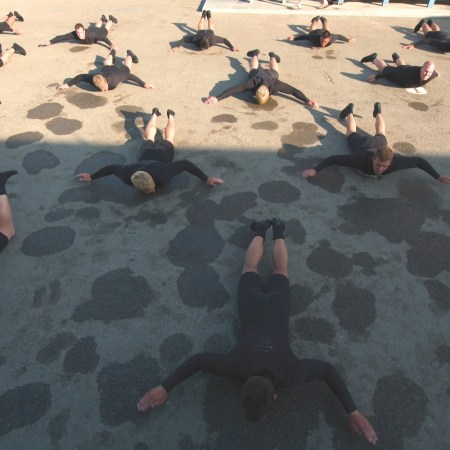What do Navy SEAL Team 6, Army Delta Force, LAPD SWAT and Bradley Cooper in American Sniper all have in common?
Besides the ability to chew tobacco in a way that suggests they’ve been doing it since birth?
All were schooled by Scott Reitz on the art of tactical gunfighting.
And now he’s instructing me.
It’s noon. There’s no shade from the SoCal sun and the ground beneath me is pushing 110 degrees as I lie prone with a mint Noveske carbine aimed downrange. My EoTech sight casts a red dot floats over a silhouetted chest 50 yards away from me. Thanks to Reitz, my weapon is expertly zeroed to nail it. Whether I’ll actually hit it, though — well, we’re about to find out.
I run through my pre-shot checklist. Stabilize the weapon. Points of contact. Establish sight picture. Deep breath. Exhale. Gentle trigger pull. No yanking.
KA-THACK. Recoil. I flick the safety on. Immediately. International Tactical Training Seminars boasts an immaculate 25-year safety record. I’m not about to muck it up three hours into my first session.
Reitz and his instructors shepherd our motley crew of police officers, ex-military, a gunsmith, lawyers, a surgeon, two women with eagle eyes and myself to our targets. Time for the verdict.
My unlucky #13 paper comes into view with the naked eye. Five shots, grouped center mass. I’m learning at the hands of a master, after all.
We live in a country gone gun-ho for shooting schools. But few can return fire with the safety record and instructor experience of International Tactical. I find this reassuring: when you’re on a range with two-dozen semi-automatic-toting strangers, elitism isn’t merely a nice touch — it’s mandatory.
ITTS’s standing stems directly from Reitz, its founder. With his ever-present sidearm and decades-long dedication to his craft, “Uncle Scotty” is a modern-day samurai. He initially learned the tricks of the trade on a four-inch LAPD-issued revolver. After year of distinguished service, Reitz was subsequently promoted to Metro D Platoon, aka Special Weapons and Tactics, aka SWAT. There, he and his comrades worked tirelessly to evolve advanced weapons tactics. Soon thereafter, he was appointed head weapons instructor for LAPD’s elite Metropolitan Division. U.S. Military Special Forces took note and came a knockin’. He learned them up, too.
It’s not an overstatement to say Scott Reitz wrote the book on the art of modern gunfighting. He literally did. It’s called The Art of Modern Gunfighting. Naturally, I, a novice, feel nowhere remotely worthy of his tutelage. But my disconnect is exactly the point, says Reitz.
“Military is serving the citizens, the police serve at the will of the citizens. We have people in the class who are ultimately going to serve on juries, sit on different panels, have a voice in the community. When they take the class, they’re learning from professionals. It better informs the public.”
As a citizen student of an eminently quotable and endlessly enlightening tactical training weekend, here’s my top five lessons learned over my two-day Carbine I class.
1. “All guns are always loaded.”
Safety first, second and always. We begin Day One with a two-hour briefing. Instructors share heart-wrenching stories of fatal weapon negligence. We learn how far a fired bullet will travel (the math has been calculated by a student who works at Jet Propulsion Laboratories) and what havoc it will wreak upon impact. I’m intimidated, and I should be. I’m handling a deadly weapon.
On Day Two, we repeat the safety briefing all over again first thing. There’s a reason Scotty’s taught tens of thousands of students over three decades without a single safety incident. As he says: “Proper inputs proper response. Improper inputs improper response. The gun doesn’t care who you are.”
But all’s not doom and gloom. If you “flag” somebody — i.e., point your barrel at them at any time, safety on or off — you have to pony up a case of premium brews, their choice. Reitz finds this keeps students more vigilant than the fear of firing an accidental round into a classmate.
2. “Get high quality right at the outset and it’ll last you a lifetime.”
ITTS keeps a box of cheap-o scopes discarded by former students. During our two-day class, sight batteries die, mags jam and all manner of mechanical hijinks take my fellow classmates “out of the fight.” But the students who invested in top-notch equipment avoid these malfunctions largely avoid these drawbacks.
Any man worth his gunpowder knows it’s more expensive to buy cheap and replace than pay for quality at the outset. More importantly, experiencing a mechanical failure mid-firefight isn’t an inconvenience. It’s life-threatening. Admittedly, ITTS courses run a shade pricier than most. That’s because their trainers are experienced LAPD SWAT instead of flimsily accredited wahoos running an over-glorified paintball course with live ammo.
If that’s not the training you want, then you don’t want ITTS. Bottom line: when it comes to weapons systems, you can buy accuracy and training. You can’t buy another life. Don’t skimp.
3. “The Iceman always wins.”
One of my classmates attended a “school” where he worked on clearing hostage situations Day One. He left in a rage after he was sent into a building where other classmates were already running a live-fire exercise. Unsurprisingly, later that year the school had a ginned-up student pop off into a classmate’s thigh.
Conversely, ITTS preaches, “the basics will save your life every time.” So we drilled them. Repeatedly.
Standard positions. Transitions. Mag reloads. Follow-through. Failure drills: two in the chest, attacker doesn’t go down, etc. Correct protocol calls for one in the head, preferably low, between the eyes (standard .223 rounds have been known to glance off the skull).
As Uncle Scotty says, “It’s easy to miss. The hard part’s to hit. And the only thing that matters in a gunfight are hits. This is why full-auto is less effective than semi-auto.” We learn to take our time and run through a mental checklist before firing. Focus. Breathe. Poise beats speed.
By Day Two I am hitting six-for-six targets from three different positions on a 22-inch wide target 150 yards out, no magnification. Overconfidence creeps in. I attempt to ratchet up the tempo on the next drill. My round bites it into the dirt five feet in front of my target.
It serves as a reminder: Don’t be hot sh*t. Do be the iceman.
4. “Gunfighting is a perishable skill.”
Each instructor at ITTS slings lead downrange every day. These men are battle-tested masters, yet they approach each session with the zeal of fresh-faced trainee. Or, as Buddhist master Shunryu Suzuki puts it: “Zen mind, beginner’s mind.”
As Scotty puts it, “We [meaning gun owners] train to one standard when a much higher standard is called for in the world … When you’re teaching what we’re teaching people it’s a broader subject than you thought at the outset, and it’s going to take a longer time to learn to apply it.”
That’s why Reitz and his instructors train themselves first and foremost. They lead by example and hold themselves to the same standards as their students. If they flag us, they owe beer, too.
5. “Get back in the fight!”
The box drill calls for six rounds on two targets. Let’s say you’re halfway through. Click. Mag empty. You can bet your granny’s sweet fanny an instructor will instantly materialize over your shoulder like a six-foot Jiminy Cricket to bark you through a reload. “Get back in the fight!”
At ITTS, safety takes precedence über alles. But the no. 2 most emphasized mantra was to Get. Back. In. The. Fight.
Have a stovepipe malfunction? Clear it. Get back in the fight. Scope gone wonky? Switch to iron sights. Get back in the fight. Your neighbor’s ejected shell casing is sizzling on your neck? Don’t even dream of flinching. Keep your eye to your scope and get back in the fight.
You perform how you train. No excuses. If you’re not firing, you’re taking fire. Do what it takes to get back in the fight.
The Charge will help you move better, think clearer and stay in the game longer. Subscribe to our wellness newsletter today.






















